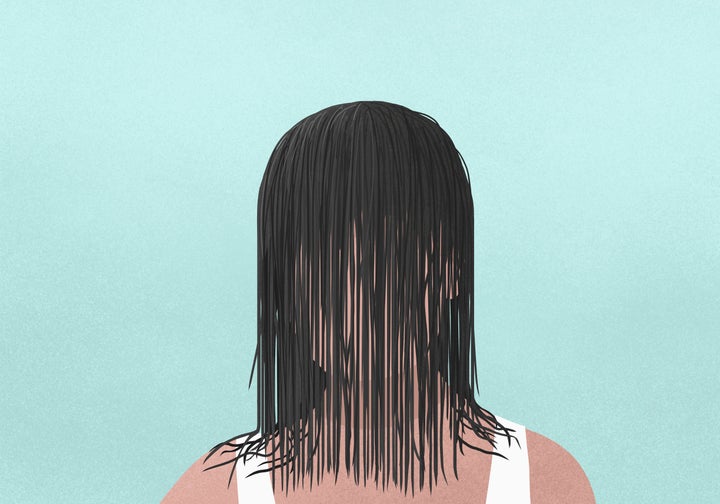
We all have hang-ups. But for people with body dysmorphic disorder (BDD) – where a person spends much of their time worrying about flaws in their appearance – that anxiety can have a drastic impact on day-to-day life and mental health.
Both men and women can develop BDD, which is most common in teenagers and young adults. People with the mental illness will often obsess over certain aspects of their appearance – often flaws which are unnoticeable to others.
Hannah Lewis, 25, was diagnosed with BDD at the age of 18, after years of feeling ashamed of her appearance. She believes her first symptoms showed at the age of eight or nine, and vividly remembers seeing a photograph of herself which prompted a panic attack. “I was hysterical and so inconsolable because I saw this photo,” she recalls. “Everyone was like: ‘what’s your problem?’ I was convinced that I was so hideous and deformed and abnormal looking.”
Much of Hannah’s teens were spent obsessing over how to do her makeup or finding ways to hide her face. She wouldn’t leave the house without a minimum of three layers of foundation and she would even wear makeup to bed.
While awareness of mental illnesses such as depression and anxiety is growing, fewer people know about body dysmorphia and, even for those that do, it can be hard to understand truly what another person is going through – or seeing when they look in the mirror. That’s why we spoke to Hannah, and two other people with BDD, to find out what they want others to know.

Body dysmorphia is not just vanity.
Katy McPhedran, 30, a social media manager living in London, says this is a major misconception that surrounds body dysmorphic disorder. “BDD is an illness, and not about vanity, which I think many people believe,” she stresses. And Hannah Lewis agrees, calling it the “one of the most dangerous misconceptions” about her condition.
It can come hand-in-hand with other mental illnesses.
Lewis has endured serious bouts of depression, anxiety and delusions, as well as BDD. When she was at university, she also began to have suicidal thoughts and tendencies towards self-harm, and became severely agoraphobic – often because she didn’t want other people to see her. “People think it’s someone who’s not happy with being attractive but in reality it’s so much more than that,” she says. “It is a serious mental health condition.”
For Ebony Nash, 25, a marketing manager based in Manchester, BDD has often been present alongside, and in conjunction with, other illnesses. Nash was about 13 when she started to experience symptoms. “A lot of people’s BDD seems to focus on one particular body part,” she explains. “Mine’s around my face shape, because I’ve got quite a round face shape. I started noticing it around the time I got diagnosed with anorexia. I think they were interlinked – I was trying to starve myself to make myself thinner.”
She adds: “It’s something that may not be a perfect thing about you but nobody else would notice it, but you’ll exacerbate it to the nth degree in your head.
It can take over your life.
Katy McPhedran says that at the height of her struggle with BDD she would obsess (and still does, to a degree) over tiny details. “I truly believed – and still believe a little – that the shape of my nose would stop me getting jobs or making friends,” she says. “It’s not just a ‘can’t look in the mirror’ or ‘looks rude for shying away from photos’ kind of feeling, it really takes over.”
Going to events would be draining, she explains, because she’d spend weeks in advance wondering what to wear or worrying about how she’d look. “I’d have anxiety leading up to it, which would impact my concentration in social situations. I’d be thinking whether the other person had noticed my nose, or my baby hairs, or weird jawline, rather than focusing on what they were saying.”

Other people could be more aware of triggers.
Nash wants others to be more aware of the major triggers for people whose mental illness focuses on appearance. “The strongest one is having my picture taken by somebody,” she says “I take an absolute shit load of pictures of myself, which is also a form of body-checking, but I cannot stand having my picture taken by somebody else.”
She will always compare herself to others in the photos. “And even if I’m the skinniest person in the picture, my face will still – because of what’s wrong with my brain – look bigger than everybody else’s and I’ll just melt down.”
Awareness of BDD is limited.
Among the wider population, there isn’t a good understanding of the illness, says Lewis, who lives in London and works for the charity Rethink Mental Illness. “I think that’s because, although it affects 1% of population, it’s really not talked about enough. And that’s why we see people reaching out for help and seeking their diagnosis a lot later than when they started having symptoms. I waited 10 years from my first symptoms.”
“Nothing’s wrong” doesn’t stick.
“My mum’s always just like: there’s nothing wrong with your face,” says Nash. “But it doesn’t matter how many times [she says that], or how many times your partner tells you you’re beautiful, that’s just the way your brain is wired. You don’t ever change your perception of it.”
It is possible to get better.
While all three women who spoke to HuffPost UK are still impacted by BDD, each feels much more control over her condition than she used to. “I can hold down a job, I have friends, I socialise and go outside,” says Hannah Lewis. But there are still days where I just can’t face other people seeing me because what I see in the mirror is just so distressing.” Lewis has engaged with multiple rounds of cognitive behavioural therapy (CBT) and psychotherapy, with medication, and now helps others with similar conditions. “It still impacts me,” she says of her BDD, “but I’m so much better than I was.”
Useful websites and helplines:
- Mind, open Monday to Friday, 9am-6pm on 0300 123 3393
- Samaritans offers a listening service which is open 24 hours a day, on 116 123 (UK and ROI - this number is FREE to call and will not appear on your phone bill.)
- The Mix is a free support service for people under 25. Call 0808 808 4994 or email: help@themix.org.uk
- Rethink Mental Illness offers practical help through its advice line which can be reached on 0300 5000 927 (open Monday to Friday 10am-4pm). More info can be found on www.rethink.org.
- Beat, Adult Helpline: 0808 801 0677 and Youthline: 0808 801 0711 or email help@beateatingdisorders.org.uk (adults) fyp@beateatingdisorders.org.uk (youth support)